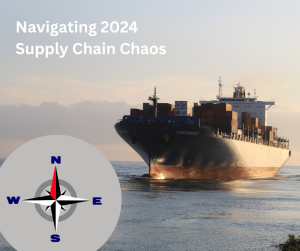
In late 2023, the import/export container industry was recovering from high volatility in both rates and transit times. Disruptions were at a minimum and while the seas were calm and ocean rates were suppressed, many companies were able to stabilize much of their supply chain challenges encountered over the last few years.
As a company, we posted a blog that you can find here: https://cargos.com/2024-whats-on-the-horizon/ outlining some of the possible concerns we had for 2024. We were closer than we thought with our predictions.
The start of 2024 has brought back the all too familiar feelings of post-pandemic supply chain chaos. Here’s what’s going on, what you need to know, and what you can do to work through the disruptions:
Suez Canal
What’s going on:
Over the past few months, carriers have foregone using the Suez Canal due to rebel attacks on shipping vessels as they traverse the Gulf of Aden on their way to the Red Sea. Many vessels were rerouted while in transit followed by new sailings intentionally routed to traverse around the Cape of Good Hope. This new transit route adds up to 18 additional days in transit. Here’s an article talking about an attack: https://apnews.com/article/houthi-drone-attacks-ship-gulf-aden-9949c0b224812fd37958709ed19dd365
What you need to know:
Dealing with the delay of vessels that have been rerouted around the southern tip of Africa is the beginning of what could be a sizeable and continuing disruptor of cargo traffic. What outsiders might not immediately consider is the initial 18-day (give or take) delay will be compounded at a staggering rate as return vessels will also have to sail around the cape. We are seeing equipment and space issues rapidly increase in India and Southeast Asia as carriers struggle to cope with the schedule disruptions.
Panama Canal
What’s going on?
The Panama Canal is drastically low on water due to ongoing droughts in the region. Container ships have had to limit the number of containers on board and the daily number of container ships allowed to pass has been severely limited. https://www.freightwaves.com/news/shipping-braces-for-impact-as-panama-canal-slashes-capacity
What you need to know:
In the years following the last slowdown of the West Coast labor union and due to much of the rail congestion in the United States over the past few years, most companies who ship containers internationally have diversified their supply chains to include both coasts. The result has been more traffic scheduled to transit the Panama Canal than ever before. Large importers who are reluctant to rely on domestic intermodal rail have moved their supply chains further east in order to take advantage of the East Coast ports and logistics options.
What you can do:
- Book early and grab space and equipment when it’s offered; carriers are limited in what they can offer and lack of space causes increased costs.
- Plan ahead to avoid problematic and expensive shipping scenarios like air freight or expedited shipping. Assume there will be additional delays even on routes that don’t transit a canal
- Track your shipment in conjunction with your freight forwarder. CSI has satellite tracking that’s updated 4x per day. If you don’t have access to this type of visibility, contact us.
- Diversify your supply chain. Stay committed to using multiple carriers, multiple routes and multiple ports. Putting all your eggs in one basket can be costly in these uncertain times.
